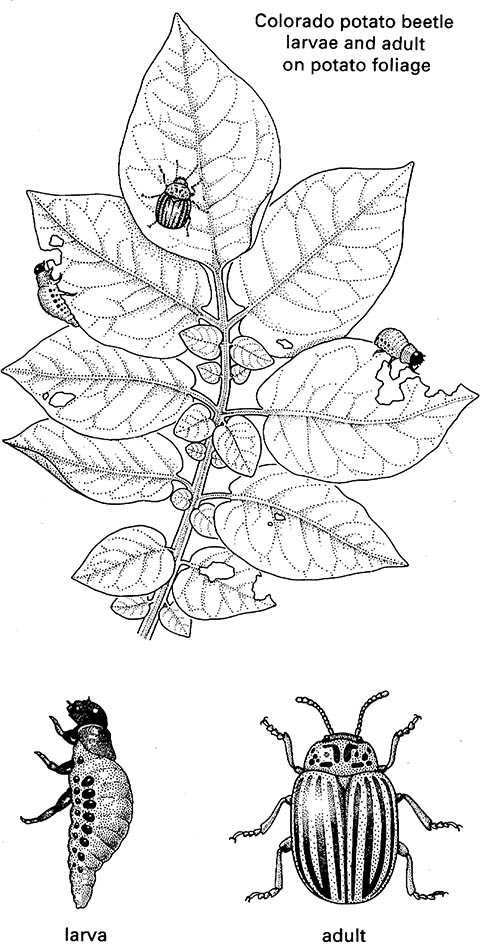Box 16.5. The Colorado potato beetle
Leptinotarsa decemlineata (Coleoptera: Chrysomelidae), commonly known as the Colorado potato beetle, is a striking beetle (illustrated here, after Stanek 1969) that has become a major pest of cultivated potatoes in the northern hemisphere. Originally probably native to Mexico, it expanded its host range about 150 years ago and then spread into Europe from North America in the 1920s, and is still expanding its range. Its present hosts are about 20 species in the family Solanaceae, especially Solanum spp. and in particular S. tuberosum, the cultivated potato. Other occasional hosts include Lycopersicon esculentum, the cultivated tomato, and Solanum melongena, eggplant. The adult beetles are attracted by volatile chemicals released by the leaves of Solanum species, on which they feed and lay eggs. Female beetles live for about two months, in which time they can lay a few thousand eggs each. Larvae defoliate potato plants (as illustrated here) resulting in yield losses of up to 100% if damage occurs prior to tuber formation. The Colorado potato beetle is the most important defoliator of potatoes and, where it is present, control measures are necessary if crops are to be grown successfully.
Insecticides effectively controlled the Colorado potato beetle until it developed resistance to DDT in the 1950s. Since then the beetle has developed resistance to each new insecticide (including synthetic pyrethroids) at progressively faster rates. Currently, many beetle populations are resistant to all traditional insecticides, although new, narrow-spectrum insecticides became available in the late 1990s to control resistant populations. Feeding can be inhibited by application to leaf surfaces of antifeedants, including neem products (Box 16.3) and certain fungicides; however, deleterious effects on the plants and/or slow suppression of beetle populations has made antifeedants unpopular. Cultural control, via rotation of crops, delays infestation of potatoes and can reduce the build-up of early-season beetle populations. Diapausing adults mostly overwinter in the soil of fields where potatoes were grown the previous year and are slow to colonize new fields because much post-diapause dispersal is by walking. However, populations of second-generation beetles may or may not be reduced in size compared with those in non-rotated crops. Attempts to produce potato varieties resistant to the Colorado potato beetle have failed to combine useful levels of resistance (either from chemicals or glandular hairs) with a commercially suitable product. Even biological control has been unsuccessful because known natural enemies generally do not reproduce rapidly enough nor individually consume sufficient prey to regulate populations of the Colorado potato beetle effectively, and most natural enemies cannot survive the cold winters of temperate potato-growing areas.
However, mass rearing and augmentative releases of certain predators (e.g. two species of pentatomid bugs) and an egg parasitoid (a eulophid wasp) may provide substantial control. Sprays of bacterial insecticides can produce effective microbial control if applications are timed to target the vulnerable early-instar larvae. Two strains of the bacterium Bacillus thuringiensis produce toxins that kill the larvae of Colorado potato beetle. The bacterial genes responsible for producing the toxin of B. thuringiensis ssp. tenebrionis (= B. t. var. san diego) have been genetically engineered into potato plants by inserting the genes into another bacterium, Agrobacterium tumefaciens, which is capable of inserting its DNA into that of the host plant. Remarkably, these transgenic potato plants are resistant to both adult and larval stages of the Colorado potato beetle, and also produce high-quality potatoes. However, their use has been restricted by concerns that consumers will reject transgenic potatoes and because the Bt plants do not deter certain other pests that still must be controlled with insecticides. Of course, even if Bt potatoes become popular, the Colorado potato beetle may rapidly develop resistance to the “new” toxins.




